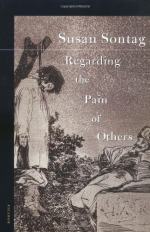
|
| Name: _________________________ | Period: ___________________ |
This test consists of 15 multiple choice questions and 5 short answer questions.
Multiple Choice Questions
1. Which technological advancement changed the way war was photographed after World War I?
(a) Weaponry.
(b) Transportation.
(c) Lightweight cameras.
(d) Lighting equipment.
2. Sontag argues that Goya's "The Disasters of War" was a turning point in the depiction of suffering. What does she cite as her reason?
(a) The captions, challenging the viewer to look.
(b) The detailed descriptions accompanying the work.
(c) The starkness of Goya's craft.
(d) The subtlety of the portrayal of war.
3. After World War I, the general public thought of the War as:
(a) The war to end all wars.
(b) An atrocity committed on the world stage.
(c) A clean, necessary and effectively fought war.
(d) A hopeless waste of human energy and life.
4. According to Sontag, war journalism first developed during which of the following two wars?
(a) World War I and World War II.
(b) The American Revolution and the American Civil War.
(c) World War II and the Vietnam War.
(d) The Crimean War and the American Civil War.
5. The Brady group's approach to war photography differed from Fenton's approach in which of the following ways?
(a) The Brady group photographed the war without government permission, while Fenton had permission for his work.
(b) The Brady group had permission to access the fields, while Fenton did not.
(c) The Brady group was not commissioned by the government, while Fenton was.
(d) The Brady group was commissioned by the government, while Fenton was not.
6. Which famous surrealist thinker does Sontag quote as saying "Beauty will be convulsive, or it will not be?"
(a) Pablo Picasso.
(b) Salvador Dali.
(c) Virginia Woolf.
(d) Andre Breton.
7. Which was the first war to be covered by television cameras?
(a) The War on Terror.
(b) The Korean War.
(c) Desert Storm.
(d) The Vietnam War.
8. According to Sontag, photographs of atrocities are best received if they are:
(a) Images of familiar places or people.
(b) So artistically simple as to seem uncomposed.
(c) Well-lit and high-contrast.
(d) Close-ups of compelling scenes.
9. Although the camera captures the scene in front of it, Sontag suggests that the ______ may manipulate the image.
(a) Editor.
(b) Photographer.
(c) Press.
(d) Media.
10. Ultimately, Sontag claims that war is:
(a) Tragic.
(b) Horrific.
(c) Avoidable.
(d) Perennial.
11. Sontag argues that a photograph by which of these photographers triggered mass outcry against the Vietnam War?
(a) Henri Cartier-Bresson.
(b) Robert Capa.
(c) Larry Burroughs.
(d) Ernst Friedrich.
12. Which antiwar book which shows images from German military archives does Sontag reference?
(a) Krieg dem Kriege!
(b) The Face of War.
(c) J'accuse.
(d) Three Guinneas.
13. According to Sontag, photojournalism was used post-9/11 to:
(a) Promote messages of peace and pacificism.
(b) Increase sensitivity toward Middle-Eastern Americans.
(c) Increase support for military action.
(d) Inform the public of the event.
14. Sontag claims that Jacques Callot's 1633 painting, "The Miseries and Misfortunes of War" was unprecedented for which of the following reasons?
(a) The painting portrayed shocking violence and bloodshed.
(b) The painting emphasized the savagery of the conquering army.
(c) The painting was the first anti-war protest work.
(d) The painting glorified the horrors of war.
15. Sontag argues that the photograph, unlike the written word, is:
(a) Always objective.
(b) Politically charged.
(c) Subject to interpretation.
(d) Artistically inferior.
Short Answer Questions
1. Noting the long history of the "iconography of suffering," Sontag lists three types of art which depict incredible agony. Which of the following is NOT one of them?
2. According to Sontag, "to photograph is to frame, and to frame is to _______".
3. According to Sontag, anti-war sentiment:
4. Which was the first war to be "covered" by professional war journalists at the front lines?
5. Which of the following is true about representations of the dead or dying in American media?
|
This section contains 684 words (approx. 3 pages at 300 words per page) |

|




